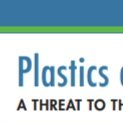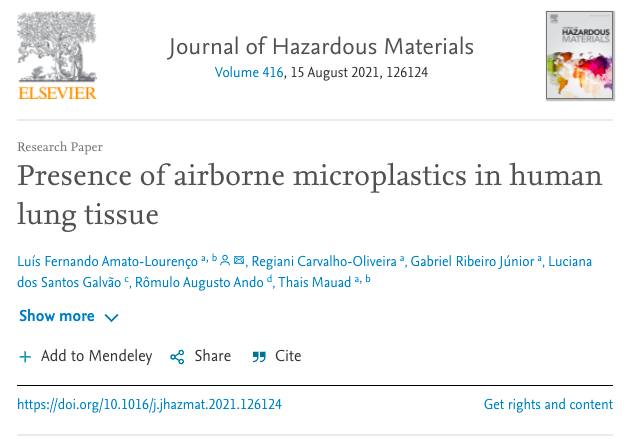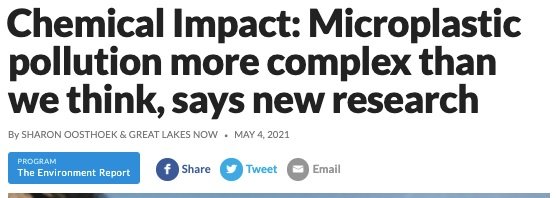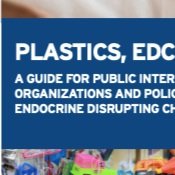
First Evidence of Microplastics in Antarctic Snow
In recent years, airborne microplastics have been identified in a range of remote environments. However, data throughout the Southern Hemisphere, in particular Antarctica, are largely absent to date. We collected snow samples from 19 sites across the Ross Island region of Antarctica. Suspected microplastic particles were isolated and their composition confirmed using micro-Fourier transform infrared spectroscopy (µFTIR).

Reckoning With the U.S. Role In Global Ocean Plastic
Reckoning with the U.S. Role in Global Ocean Plastic Waste calls for a national strategy by the end of 2022 to reduce the nation's contribution to global ocean plastic waste at every step - from production to its entry into the environment - including by substantially reducing U.S. solid waste generation.

Plastics and Microplastics: A Threat to the Environment and Health
EHHI reviewed nearly 500 scientific studies for this report and found that each of us ingests and inhales millions of microscopic plastic particles each year. Microplastics carry chemical additives and coatings as well as potentially pathogenic microbes. Disturbingly, their impact on human health is not yet known.

A Rapid Review and Meta-regression Analyses of the Toxicological Impacts of Microplastic Exposure in Human Cells
The prevalence of microplastics (MPs) is ubiquitous, found in almost every compartment of the environment; in the air (Wright et al., 2020), food (Teng et al., 2019) and drinking water (Zhang et al., 2020). MP contamination will continue to rise as plastic production and use around the world increases (Lebreton and Andrady, 2019). If plastic waste mismanagement continues as it is or increases, it is predicted that within a century, MP ecological risks will be widespread in ecosystems across the world (SAM, 2019; SAPEA, 2019).

The Global Threat From Plastic Pollution
The rational response to the global threat posed by accumulating and poorly reversible plastic pollution is to rapidly reduce plastic emissions through reductions in consumption of virgin plastic materials, along with internationally coordinated strategies for waste management.

Presence of airborne microplastics in human lung tissue
Microplastics are present in the air and may be inhaled by humans, but whether they have deleterious effects on the respiratory system remain unknown. In this study, we determined the presence of microplastics in human lung tissues obtained at autopsies.

High frequency of micro- and meso-plastics ingestion in a sample of neonate sea turtles from a major rookery
Evidence points to plastics ingestion being an important source of population-level effects in neonate sea turtles.

Chemical Impact: Microplastic pollution more complex than we think, says new research
Microplastic pollution has been building up in the Great Lakes for at least four decades, but our understanding of its impact on fish and other aquatic creatures is only just catching up.

Aquatic Pollutants In Oceans And Fisheries
Pollutants including industrial chemicals, pesticides, pharmaceuticals, heavy metals, plastics and microplastics have deleterious impacts to aquatic ecosystems at all trophic levels from plankton to whales.

Constraining the atmospheric limb of the plastic cycle
In modeling the atmospheric limb of the plastic cycle, we show that most atmospheric plastics are derived from the legacy production of plastics from waste that has continued to build up in the environment.

Microplastics Found in 100 Percent of Tested Pennsylvania waterways
At 53 waterways tested across Pennsylvania, microplastic contamination was found in every spot, from Lake Erie, Pittsburgh's Three Rivers and the Delaware River, according to a new report entitled Microplastics in Pennsylvania: a Survey of Waterways released Wednesday.

Plastics, EDCs & Health
A guide for public interest organization and policy-makers on endocrine disrupting chemicals and plastics.

Plastics Pose a Threat to Human Health
Authoritative reports shows plastics and microplastics are pervasive sources of exposure to dangerous endocrine-disrupting chemicals.

Microplastics weathered by water are more likely to infiltrate an animal’s cells
A new study finds microplastics exposed to freshwater or saltwater for several weeks are around 10 times more likely to enter the cells of mice compared to pristine particles.

Plastic pollution is killing marine megafauna, but how do we prioritize policies to reduce mortality?
Pollution by plastic and other debris is a problem affecting the world's oceans and is increasing through time... Marine megafauna are known to mistakenly eat anthropogenic debris and die from consequent gastrointestinal blockages, perforations and malnutrition, as well as suffer sublethal impacts.

Plasticenta: First evidence of microplastics in human placenta
Microplastics are particles smaller than five millimeters deriving from the degradation of plastic objects present in the environment. Microplastics can move from the environment to living organisms, including mammals. In this study, six human placentas, collected from consenting women with physiological pregnancies, were analyzed by Raman Microspectroscopy to evaluate the presence of microplastics.

Choked, Strangled, Drowned: The Plastics Crisis Unfolding In Our Oceans
After surveying dozens of government agencies, organizations and institutions that collect data on the impact of plastic on marine animals, Oceana found evidence of nearly 1,800 animals from 40 different species swallowing or becoming entangled in plastic since 2009. Of those, a staggering 88% were species listed as endangered or threatened with extinction under the Endangered Species Act.

Plastic & Climate: The Hidden Cost of a Plastic Planet
The plastic pollution crisis that overwhelms our oceans is also a significant and growing threat to the Earth’s climate. At current levels, greenhouse gas emissions from the plastic lifecycle threaten the ability of the global community to keep global temperature rise below 1.5°C. With the petrochemical and plastic industries planning a massive expansion in production, the problem is on track to get much worse.

Plastic and Health: The Hidden Cost of a Plastic Planet
This report provides a detailed overview of the health impacts associated with plastic at every stage of its supply chain and lifecycle, and it reveals the numerous exposure routes through which human health is impacted at each stage.

